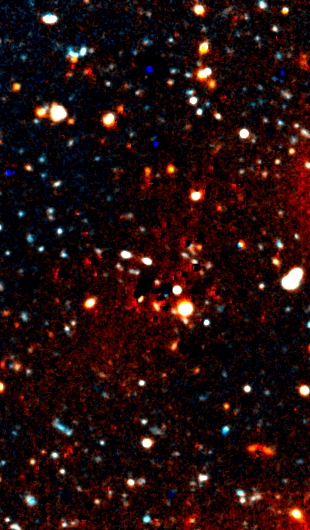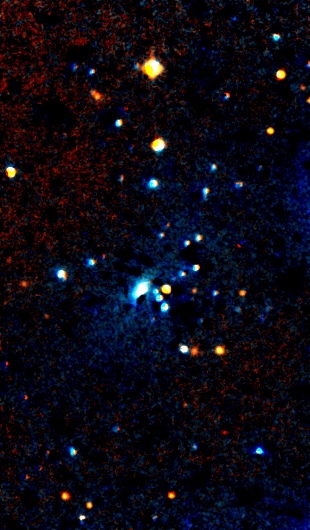

A 80×195 arcsec area in the center of A370 imaged
on the CFHT by Jean-Paul Kneib and collaborators at Toulouse. The image
is a real color BRI composite with 0.6 arcsec seeing. Note that the
radial arc is visible in the envelope of the lower D galaxy by virtue
of its very blue color.
A 150×150 arcsec area in the core of A1689 imaged
with WFPC2 in F606W/F814W. Nothing red and obvious in the field -
compare this image to the F606W/F814W composite of the z=4.92 galaxy in
MS1358+62 (here).
A 40x40 arcsec region around the central galaxy of
MS1514+36 imaged with WFPC2 in F555W/F675W. The object just below and
to the left of the central galaxy is the z=2.7 `Proto-galaxy' of Yee et
al. (1996). This is apparently highly distorted and magnified by the
(marginal) cluster lens. Also note the large amount of dust
projected onto the central galaxy. Isn't the ST-ECF Archive a
wonderful thing... :)
A 40×40 arcsec region around the central galaxy of
Cl1358+62 imaged with WFPC2 in F606W/F814W. The z=4.9 galaxy is the
red arc above the central galaxy. The frames weren't dithered which
accounts for the noisy background of hot pixels (I haven't tried hard
to clean them yet). The link gives a larger field of view (150×150
arcsec) to help identify `G2'.
The central regions of the rich cluster of galaxies
Abell 2218 (z=0.18). This is false-color representation of a three
orbit HST/WFPC2 F702W (red) image, the field size is roughly 40×120
arcsec. There is an obvious population of tangentially aligned images
(called `arcs') around both the central galaxy and its bright
companion. These are gravitationally lensed images of background field
galaxies, the distortion induced in their images (see the lower image)
holds clues to both their distance behind the
cluster and also the distribution of mass within the cluster
lens. Using the observed shapes of these arcs an accurate model has
been constructed for the dark matter in the cluster and this model has
then been applied to determine the distances to a large sample of very
faint field galaxies - far beyond the reach of conventional
spectroscopy on even 10-m class telescopes. The accuracy of these
predictions has been recently confirmed
using spectroscopic observations of some of the brighter arclets. In
particular a star-forming galaxy with a predicted redshift of
z=2.8±0.3 was confirmed to lie at
z=2.515.
A simulation showing how Abell 2218 would
appear if mapped at 850um using the new SCUBA
sub-mm array on the JCMT telescope, Mauna Kea. This image
represents the equivalent of 12 hours integration on source and
illustrates the strong constrast between the quiescent cluster
ellipticals and the star-forming galaxies seen as giant arcs through
the cluster lens. Such observations will provide strong constraints
on the nature of galaxies in the distant Universe. For REAL
SCUBA observations of lensing clusters see this page.
An HST/WFPC2 F702W (red) image of the core of the cluster AC114
(z=0.31). A number of multiply-imaged background galaxies are visible
in this image, they appear as distinct images showing mirror symmetry.
Two striking examples lie to the right of the central galaxy near the
edge of the frame, including two images of a knotty `C'-shaped
feature. A detailed mass model of the cluster
lens has been constructed and indicates that the this galaxy probably
lies at z=2.3. The brightest multiply-imaged feature in this field
lies to the upper-right of the central galaxy - two compact images with
mirror-symmetric tails. A zoom of these features is shown below.
Other images of this cluster can be found here.
A zoom into the image shown above to demonstrate the high symmetry of
one of the multiply-imaged sources. This object has been
spectroscopically identified as a z=1.86 star-forming galaxy. The
positions, orientations and relative brightnesses of these images have
been used to accurately model the distribution and amount of dark
matter in the central regions of the cluster. The observations of
this feature are discussed in more depth here.
JPK's new
identification of object D1-D5 in AC114. There are now three 5-image
systems (A1-A5, B1-B5 and D1-D5) and two 3-image systems (S1-S3 and
C1-C3). Although two of the 5-image configurations are just slightly
perturbed 3-image systems, where masses associated with individual
cluster galaxies have created extra images. Note: the labelling on
the figure is old - Q1-Q3 are S1-S3 and the images A4 and B3 have
been redesignated to show they are both double images.
A zoom in on the core of AC114 to show more
detail in the various multiply-imaged sources. In particular the
peculiar morphology of the source seen as C1-C2-C3 - this is believed
to lie at z=2.1 and is clearly a very elongated galaxy with a ridge of
strong star-formation. The higher surface brightness source B1-B5
shows much less structure and has a predicted redshift of z=1.2, while
the clumpy object seen as A1-A5 is expected to lie at z=1.7.
Therefore, along with the spectroscopically-identified galaxy S1-S3,
this small region of the sky contains at least 4 high redshift galaxies
each of which is being multiply-imaged. The high density of these
distant galaxies attests to the strong amplification arising from and
the high mass of the foreground lensing cluster.
A series of color image of AC114 (z=0.31) taken with
the AAT by Warrick Couch
and using data from the Danish 1.5m at La Silla.
The frames are 2.0×3.5 arcmin
and are made from deep B, V and I images. The central panel shows
the true color BVI image, the panel to the left shows an image
made with (B-V) and (V-I) exposures as `blue' and `red'. These
color-subtracted images were scaled to remove the cluster ellipticals
from the individual exposures. The panel to the right shows the
reversed (V-B) and (I-V) exposures. In this panel anything which
is bluer than the cluster ellipticals in (V-I) and redder in (B-V)
will appear as `yellow'.
The 17 non-stellar objects with I<21 and
(B-I)>4.2 selected from the above cluster. This color limit is
applicable to a non-evolved elliptical SED at z>0.6. The three of
these which lie on the HST field are confirmed as non-stellar, the four
red stars that lie in this region are also correctly identified. Each
subframe is 27 arcsec wide (and these are rotated by 90 deg ccw
compared to the field above). Objects at [4,1], [1,2] and [3,2] lie on
WFPC2 field and are non-stellar (see below), object at [5,3] lies off
the HST field but is a true drop-out with (B-I)>5.5.
Images of the 7 red objects lying on the WFPC2 field. The bottom row
has the four stars (the first one may be slightly non-stellar), the
top row has the three galaxies listed above in the same order. The
scale is in arcseconds.
A true-color image of the lensed features in the distant cluster
Cl0024+16 (z=0.39). Five images of a blue background galaxy are
visible around the cluster center (3 at the top of the frame, 1 at the
bottom and 1 in the center between the 4 bright cluster galaxies), this
object appears to be
a ring system with a number of bright knots around the ring. The
identification of an image of the background galaxy in the central
regions of the cluster is crucial for
understanding the distribution of dark matter in the cluster core.
The compact cluster Cl2244-02 at z=0.33 imaged with HST/WFPC2
in F555W/F814W. These images were combined to make the `true-color'
image displayed below. The target of this observation was the bright
semi-circular arc seen to the left of the cluster core, this has
been spectroscopically identified as a z=2.235 galaxy, at the time the
highest redshift `normal' galaxy known. The giant arc actually
comprises two highly distorted images of the background galaxy
which is thought to be a face-on spiral (see zoom). The two images
have mirror symmetry and the relative magnifications and
features shown by the two halves have led to a detailed
understanding of the dark matter profile in the very central regions
of this cluster. A number of other lensed features are
visible around the frame.
A true-color image of the distant cluster A2390 (z=0.23), formed from
F555W and F814W exposures. The central cluster galaxy lies slightly to
the left of center in the field, a faint red arc can be seen around
this galaxy as well as a number of bluer multiply-imaged sources. The
wide elongated feature lying next to the second brightest cluster
galaxy (center-right) is an lensed image of z=0.913 spiral galaxy, part
of a group of galaxies lying at this redshift which can be identified
by their yellow colors.
Last Modified: April 25th, 1997. [Netscape 2.0]




HOME PAGE
